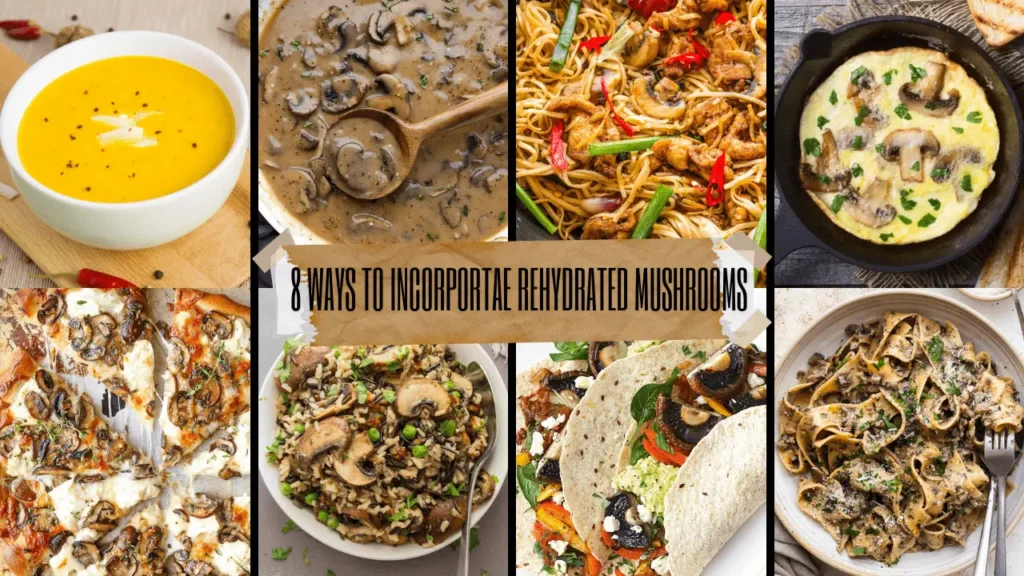Easy Steps to Dehydrating Mushrooms

Dehydrating Mushrooms preserves their flavor, extends their shelf life, and creates a convenient pantry staple. They offer a versatile ingredient for cooking year-round, adding rich flavor to a variety of dishes, from soups and sauces to risottos and stir-fries.
What are Dehydrated Mushrooms?
Dehydrated mushrooms are fungi from which moisture has been removed through drying. They retain flavor and nutrients while becoming lightweight and easy to store. Rehydrating them with water or adding them to dishes revitalizes their texture and taste. They are versatile ingredients, ideal for soups, sauces, and culinary creations.
Benefits of Dehydrating Mushrooms?
Dehydrating Mushrooms has the following benefits:
- Dehydrating mushrooms preserve their natural flavor, enhancing their taste and aroma.
- Removing moisture from mushrooms extends their shelf life, reducing the risk of spoilage.
- Dehydrated mushrooms are lightweight and compact, saving storage space compared to fresh mushrooms.
- Dehydrated mushrooms retain nutritional value, including vitamins, minerals, and antioxidants.
- Dehydrated mushrooms can be rehydrated and used in a variety of recipes, providing convenience and flexibility in cooking.
How to choose the right mushroom for dehydration?
Choosing the right mushrooms for dehydration is essential. So,
- Choose mushrooms that are firm and free from bruises or blemishes. Avoid mushrooms that are soft or mushy, as they may not dehydrate properly.
- Opt for fresh mushrooms that have a vibrant color and a strong, earthy aroma. Avoid mushrooms that appear wrinkled or have a dull color.
- Different mushroom varieties dehydrate differently, so consider the specific characteristics of each type. Common choices for dehydration include button mushrooms, shiitake mushrooms, porcini mushrooms, and oyster mushrooms.
- Select mushrooms that are uniform in size for consistent drying. Smaller mushrooms may dehydrate more quickly and evenly than larger ones.
- Choose mushrooms with a dense texture, as they will dehydrate more effectively than those with a high water content. Mushrooms with thick caps and sturdy stems are typically better suited for dehydration.
How to prepare mushrooms for dehydration?
- Start by gently cleaning the mushrooms to remove any dirt or debris. Use a damp paper towel to wipe the mushrooms clean. Avoid rinsing them under running water, as mushrooms absorb moisture easily.
- Trim off any tough or woody stems from the mushrooms, as they may not dehydrate well and can affect the texture of the finished product.
- Slice the mushrooms into uniform pieces to ensure even drying. Depending on your preference and the size of the mushrooms, you can slice them into thin slices or quarter them.
- Pre-treating mushrooms can help preserve mushrooms color and flavor during dehydration. This can be done by blanching the sliced mushrooms in boiling water for about 1-2 minutes, then immediately plunging them into ice water to stop the cooking process. However, this step is optional and may not be necessary for all recipes.
How To Dehydrate Mushrooms?
There are several methods and techniques you can use to dehydrate mushrooms, depending on the equipment you have available.
A. Dehydrate Mushrooms using a Food Dehydrator:
Pros
- They provide a controlled environment with consistent temperature and airflow, ensuring thorough dehydration without the risk of over-drying or under-drying.
- Dehydrators are easy to use and require minimal monitoring once the mushrooms are placed inside. Simply set the temperature and timer according to the manufacturer’s instructions, and the dehydrator will do the rest of the work.
- Food dehydrators operate at low temperatures, which helps preserve the nutritional content and natural flavor of the mushrooms.
Cons
- Food dehydrators, although potentially cost-saving in the long run, can be initially pricey, discouraging some due to the upfront expense.
- Most food dehydrators have a limited capacity, you can only dehydrate a certain amount of mushrooms at a time. If you have a large quantity of mushrooms to process, you may need to work in batches, which can be time-consuming.
- Food dehydrators can take up valuable counter space or storage space in your kitchen when not in use.
Process:
- Clean and Prep: Clean the mushrooms by gently wiping them with a damp cloth or brush to remove any dirt. Trim off any tough stems and slice them evenly.
- Pre-treatment (Optional): Some prefer to pre-treat mushrooms to retain color and flavor. You can blanch them briefly in boiling water for 1-2 minutes, then immediately transfer them to an ice bath to stop the cooking process.
- Arrange on Trays: Lay the sliced mushrooms in a single layer on the dehydrator trays, making sure they are not touching or overlapping. This ensures even airflow and drying.
- Set Temperature: Set the dehydrator to a temperature between 125-135°F (50-60°C). Different dehydrators may have slight variations, so refer to your dehydrator’s manual for specific instructions.
- Dehydrate: Allow the mushrooms to dehydrate for approximately 6-8 hours, or until they are dry and brittle. Thicker slices may take longer to dehydrate.
- Check for Dryness: Periodically check the mushrooms for dryness by touching them. They should be crisp and break easily when bent.
- Cool and Store: Once fully dehydrated, allow the mushrooms to cool completely before storing them in an airtight container. Store in a cool, dry place away from direct sunlight.
B. Dehydrate Mushrooms in the oven:
Pros
- Most kitchens have an oven, making it a convenient option for dehydrating mushrooms without needing to purchase additional equipment.
- Ovens can be set to low temperatures, allowing for precise control over the drying process and enabling the dehydration of other foods alongside mushrooms.
- Ovens can provide relatively even drying results with proper spacing and occasional rotation.
Cons
- Dehydrating mushrooms in an oven typically takes longer compared to specialized dehydrators, as ovens are not specifically designed for this purpose.
- Ovens consume more energy compared to dehydrators, potentially leading to higher utility bills, especially if used frequently for dehydration.
- The capacity for dehydrating mushrooms in an oven is often smaller compared to dehydrators, which may require multiple batches for larger quantities, increasing overall time and effort.
Process:
- Preheat the Oven: Preheat your oven to its lowest setting, usually around 140°F (60°C) or slightly higher.
- Clean and Slice Mushrooms: Clean the mushrooms by gently wiping them with a damp cloth or brush to remove any dirt. Trim off any tough stems and slice them evenly.
- Arrange on Baking Sheets: Lay the sliced mushrooms in a single layer on baking sheets lined with parchment paper. Make sure they are not touching or overlapping to ensure even drying.
- Place in the Oven: Place the baking sheets in the preheated oven. Keep the oven door slightly ajar to allow moisture to escape and promote airflow.
- Monitor and Rotate: Check the mushrooms periodically to ensure they are drying evenly. Rotate the baking sheets or flip the mushrooms if necessary to promote even drying.
- Dehydrate Until Crisp: Depending on the thickness of the slices and the moisture content of the mushrooms, dehydration may take anywhere from 2 to 6 hours or longer. The mushrooms should be dry and crisp when done.
- Cool and Store: Once fully dehydrated, remove the mushrooms from the oven and allow them to cool completely. Store them in an airtight container in a cool, dry place away from direct sunlight.
C. Dehydrate mushrooms using an Air Dry Method:
Pros
- The air drying method requires no special equipment, making it accessible to anyone with basic kitchen supplies.
- Since it doesn’t require electricity or additional equipment, air drying mushrooms can be a cost-effective method compared to using a dehydrator or oven.
- Air drying mushrooms is a straightforward process that involves minimal effort and preparation, making it suitable for beginners.
Cons
- Air drying can take longer time compared to using a dehydrator or oven, as it relies solely on natural airflow and can be affected by outside weather.
- Without controlled temperature and humidity levels, there’s a higher risk of contamination or spoilage during the drying process, especially in humid climates.
- Air drying may result in uneven drying and inconsistent texture, as mushrooms may not dry uniformly due to variations in airflow and temperature.
Process:
- Clean and Slice Mushrooms: Clean the mushrooms by gently wiping them with a damp cloth or brush to remove any dirt. Trim off any tough stems and slice them evenly.
- Optional Pre-treatment: Some prefer to pre-treat mushrooms to retain color and flavor. You can blanch them briefly in boiling water for 1-2 minutes, then immediately transfer them to an ice bath to stop the cooking process. However, this step is optional.
- Arrange on Racks or Screens: Lay the sliced mushrooms in a single layer on racks or screens. Ensure that there is space between each slice to allow for adequate airflow.
- Place in a Well-Ventilated Area: Find a well-ventilated area with good airflow, such as near an open window or using a fan. Avoid areas with high humidity or direct sunlight, as this can affect the drying process.
- Allow to Air Dry: Leave the mushrooms to air dry for several days to a week, depending on environmental conditions and the thickness of the slices. Check the mushrooms periodically to ensure they are drying evenly.
- Monitor for Dryness: The mushrooms are fully dehydrated when they are dry and brittle to the touch. Thicker slices may take longer to dry.
- Cool and Store: Once fully dehydrated, remove the mushrooms from the racks and allow them to cool completely. Store them in an airtight container in a cool, dry place away from direct sunlight.
D. Dehydrate mushrooms in an Air Fryer:
Pros
- Air fryers can dehydrate mushrooms faster than traditional methods, thanks to the circulating hot air, reducing overall drying time.
- Air fryers are compact and can fit easily on countertops, making them suitable for kitchens with limited space.
- Air fryers often come with multiple functions, allowing you to dehydrate mushrooms along with other foods, maximizing the appliance’s utility.
Cons
- Air fryers have a smaller capacity compared to dedicated food dehydrators, so you may need to dehydrate mushrooms in multiple batches for larger quantities.
- The airflow in air fryers may not be as evenly distributed as in food dehydrators, leading to potential inconsistencies in drying mushrooms.
- If the air fryer has been used to cook strongly flavored foods previously, there’s a risk of flavor transfer to the mushrooms during dehydration.
Process:
- Clean and Slice Mushrooms: Clean the mushrooms by gently wiping them with a damp cloth or brush to remove any dirt. Trim off any tough stems and slice them evenly.
- Preheat the Air Fryer: Preheat your air fryer to its lowest temperature setting, typically around 120°F (49°C) or the lowest available setting.
- Arrange Mushrooms in Basket: Lay the sliced mushrooms in a single layer in the air fryer basket. Ensure that there is space between each slice to allow for adequate airflow.
- Dehydrate: Place the basket in the air fryer and dehydrate the mushrooms for several hours, checking periodically for dryness. The exact drying time will vary depending on the thickness of the slices and the moisture content of the mushrooms.
- Shake or Stir Mushrooms: Shake or stir the mushrooms occasionally to promote even drying and prevent them from sticking together.
- Check for Dryness: The mushrooms are fully dehydrated when they are dry and crisp to the touch. Thicker slices may take longer to dehydrate.
- Cool and Store: Once fully dehydrated, remove the mushrooms from the air fryer and allow them to cool completely. Store them in an airtight container in a cool, dry place away from direct sunlight.
How To Rehydrate Mushrooms?
- Choose a Method: There are a few methods for rehydrating mushrooms. The most common methods include soaking in water, broth, or wine.
- Select a Liquid: Place the dried mushrooms in a bowl and cover them with hot water, broth, or wine. The liquid should be hot but not boiling.
- Soak the Mushrooms: Allow the mushrooms to soak in the liquid for about 20-30 minutes, or until they have fully rehydrated. The exact soaking time may vary depending on the size and thickness of the mushrooms.
- Stir Occasionally: Stir the mushrooms occasionally to ensure that all pieces are evenly rehydrated.
- Use in Recipes: Rehydrated mushrooms can be used in a variety of recipes, such as soups, stews, sauces, and stir-fries. Simply add them to your recipe as you would fresh mushrooms.
How To Use Rehydrated Mushrooms in Recipes?

- Soups and Stews: Add rehydrated mushrooms to soups and stews for an earthy flavor and meaty texture. They pair well with vegetables, grains, and meats, enhancing the overall richness of the dish.
- Sauces and Gravies: Incorporate rehydrated mushrooms into sauces and gravies to add complexity and depth of flavor. They can elevate the taste of pasta sauces, mushroom gravies, and creamy dishes like risottos and casseroles.
- Stir-Fries and Stir-Fried Noodles: Include rehydrated mushrooms in stir-fries and stir-fried noodles for an umami-packed ingredient that pairs well with other vegetables, proteins, and sauces.
- Omelettes and Quiches: Fold rehydrated mushrooms into omelets and quiches for a savory filling that complements eggs and cheese. They add richness and texture to these breakfast or brunch favorites.
- Pizza Toppings: Use rehydrated mushrooms as a topping for homemade or store-bought pizzas. They add a meaty texture and robust flavor that pairs well with other pizza toppings like cheese, tomatoes, and herbs.
- Rice and Grain Dishes: Mix rehydrated mushrooms into rice and grain dishes such as pilafs, risottos, and fried rice. They add depth of flavor and visual interest to these hearty side dishes.
- Sandwiches and Wraps: Layer rehydrated mushrooms onto sandwiches and wraps for added flavor and texture. They pair well with cheese, greens, and condiments, creating a satisfying and flavorful meal.
- Pasta and Noodle Dishes: Toss rehydrated mushrooms with cooked pasta or noodles and your favorite sauce for a delicious and hearty meal. They add a meaty texture and earthy flavor to pasta dishes like spaghetti, fettuccine, and lasagna.
FAQs
Q1. How long do dehydrated mushrooms last?
Dehydrated mushrooms can last for months to a year when stored in an airtight container in a cool, dry place.
Q2. Can I rehydrate dehydrated mushrooms with cold water?
Yes, although it may take longer, soaking dehydrated mushrooms in cold water will eventually rehydrate them.
Q3. Can I use the soaking liquid from rehydrated mushrooms in recipes?
Yes, the soaking liquid, or mushroom broth, is flavorful and can enhance soups, sauces, and risotto.
Q4. Can I dehydrate different types of mushrooms together?
Yes, you can mix different mushroom types for dehydration, but choose ones with similar textures and moisture levels for consistent results.
Q5. Are dehydrated mushrooms as nutritious as fresh mushrooms?
Dehydrated mushrooms retain much of their nutritional value, offering a convenient and nutritious ingredient for various recipes.







